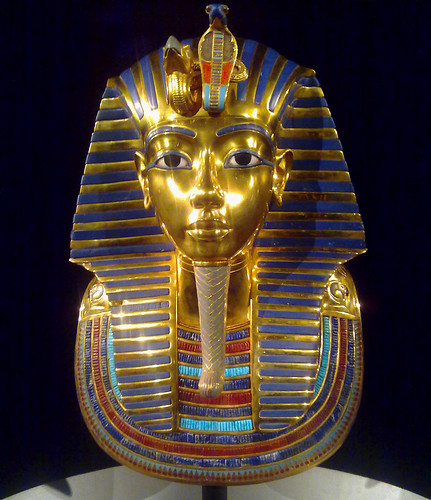The famous funerary gold mask that covered his mummified face has eyebrows painted to extend as far as the lines of the eyeliner, creating parallel lines toward his temples. Artists then as now often created stylized images, so it isn't possible to know how close the mask or other portraits come to his actual appearance and makeup style. The young king probably wore lip color as well.
A cosmetic jar found in his tomb has a detailed carving of a lion on its lid, and still bore traces of resins from vegetables and animal fat, according to Zahi Hawass's book, Tutankhamun and the Golden Age of the Pharaohs.
A reconstruction of how the young king might have looked includes thick black eyeliner and large ear piercings. The boy king's fine features and full lips give him an androgynous appearance. He would have worn a wig over his shaved head.
Tut's History
Tutankhamun might not have been a particularly celebrated king if it wasn't for the discovery of his sealed tomb. The gold and skillfully-worked artifacts in his rich burial captured the world's imagination. He took the throne of Egypt at about age eight and died at 18. This New Kingdom ruler reigned in the 18th Dynasty, from c. 1332 to 1323. His reign seems to have been unremarkable.He was the son of Akhenaten, the heretic pharaoh who may have been succeeded by his wife, Nefertiti. In 2008 Discovery News reported Hawass's find of an image and inscription in stone referring to Tut and his wife as children of Akhenaten. The discovery confirmed that the young king grew up in el Amarna. Pharaoh Akhenaten became infamous for overthrowing the pantheon of Egyptian gods and introducing monotheism to Egypt.
In his own time, Tut might been best known for rejecting the heretical religious changes of Akhenaten and restoring the original gods to their former status. The boy-king married the third daughter of Akenaten and Nefertiti, Ankhsenpaaten, his half-sister.
The sight of gold in the sealed tomb captivated people from the moment it was opened in 1922 and still draws crowds to Tut exhibits. Because so many tombs have been looted throughout history, this was a rare find.
The tomb contained jewelry, furniture, statues, chariots, a royal nesting sarcophagus, the young king's mummy and other priceless artifacts. The chests that contained the royal wardrobe, from baby clothes to underwear, remained unexplored for decades. The young king's cosmetic supplies from the tomb have been included in books and exhibits.
 |
Art from his time shows him with bronze skin, even, attractive features, dark eyes and a medium build. Based on reconstructions of garments found in his tomb, the young king had a 31-inch chest, 29-inch waist and 43-inch hips, the Guardian reported. These measurement indicate he had the same wide-hipped figure Akhenaten appears to have had, based on images from the time.
